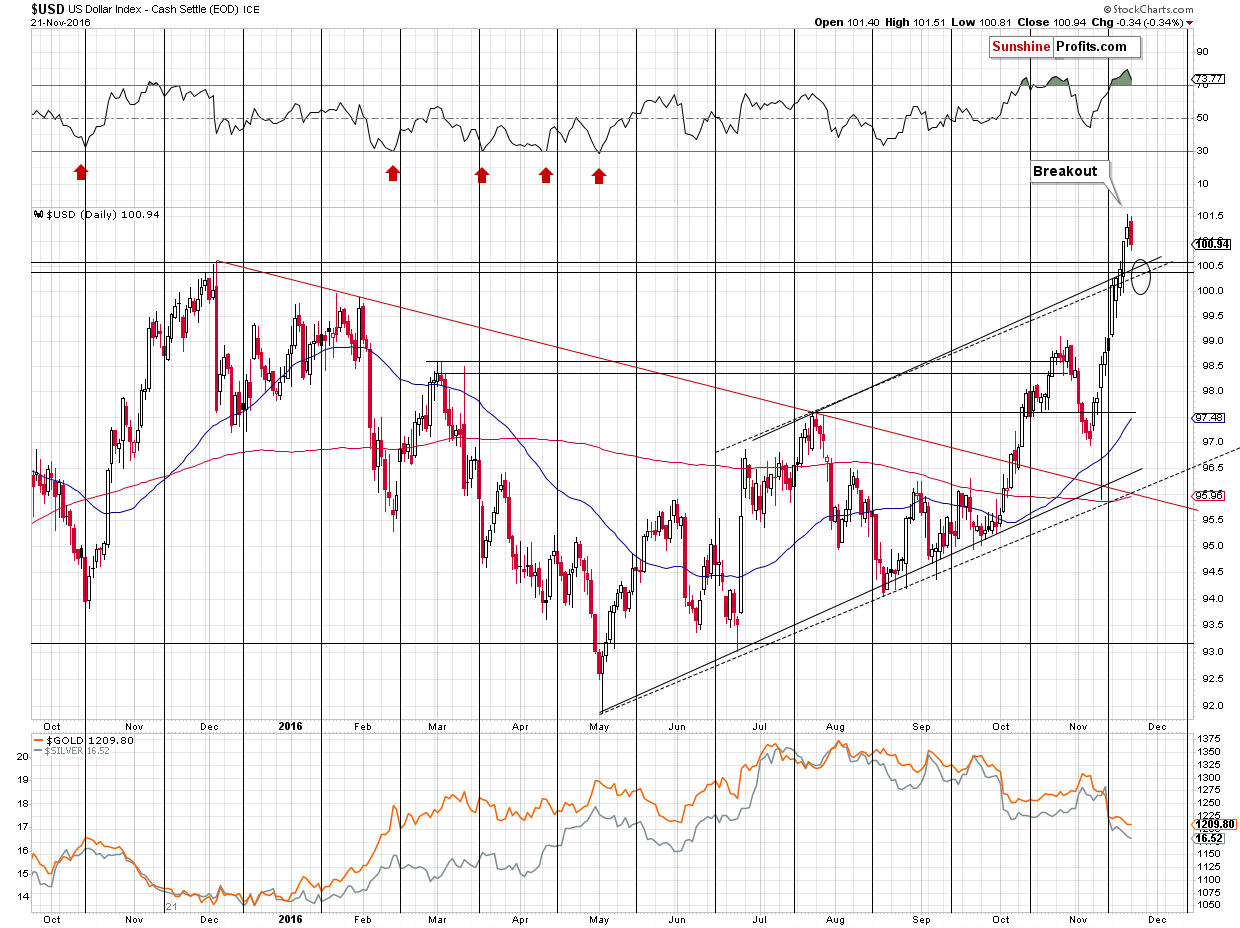We wrote on Monday that staying on the sidelines appeared to be a good idea for the next several days as the short-term outlook became more bullish, even though the medium-term outlook became more bearish (due to the USD’s breakout). Actually, just as Monday’s alert was sent, gold and silver prices were below the entry prices, so the position was closed at a profit.
Not much changed on Monday – the USD declined a bit, while the opposite was the case with gold, silver and mining stocks. Nothing extraordinary took place.
However, Tuesday’s pre-market trading was more interesting. The USD Index was basically flat, but silver jumped up almost $0.30, showing strength. Gold was up as well. The above relative price moves confirm that the precious-metals sector really wants to move higher in the short term and that until it does, daily declines will be limited. Let’s take a look at the USD Index.

source: stockcharts.com
What’s Likely To Happen Next?
The USD Index is likely to verify the breakout above the previous highs. The support levels are between 100 (an extremely round number) and 100.60 (intra-day December 2015 high) -- a wide area -- so the specific target is unclear, so it doesn’t seem that we can base our entry point in metals and miners on the USD Index alone. We can, however, look for confirmations from the precious metals themselves, once the USD is within the target area.
Two very important confirmations would be: the miners’ underperformance and silver’s very short-term outperformance. Another would be gold moving a bit above its 300-day moving average (for instance to $1,250).

source: stockcharts.com
In addition to moving to the previous 2016 lows, gold moved to the 300-day moving average and the declining red support line – the upper border of the previous trading channel. Consequently, it’s no wonder we saw a pause here. Does the above imply that a big turnaround will be seen shortly? Not necessarily. The analogy to 2013 remains in place, so we could see some strength, but it’s likely to be limited. In the case of gold, we can expect a rally that is similar to the rally that took place at the end of 2012 and in early 2013. Back then, gold moved a bit above the 300-day moving average and to a round number ($1,700). At this time, an analogous move that would take gold to about $1,250. $1,300 could also be seen, but we don’t view it as likely – the move higher would be too big to be similar to what happened in early 2013 and it doesn’t seem that the USD Index would decline significantly enough to trigger such a big rally in gold.
While we’re at gold’s long-term chart, let’s take a moment to once again go through the “why isn’t the bottom already in” question. In short, because the gold market was not hated enough back in late 2015. Major tops and major bottoms are formed when everyone gets on a given side of the market. At the top, everyone wants to buy. At the bottom, they want to sell thinking that the price will fall further. We’ve been monitoring surveys, predictions, headlines, website traffic, popularity of gold-related search terms and it doesn’t seem that gold is really hated enough for this to be the final bottom. Naturally, local tops and bottoms need to take place every now and then regardless of the bigger trend, as no market can move up or down in a straight line. There were local bottoms in 2013, in 2014 and 2015. Why would the December 2015 bottom be THE bottom if it weren’t accompanied by extreme pessimism?
Some may say that the size of the rally that followed confirms that it was indeed the final bottom. We disagree – there were 2 very good reasons for this temporary upswing to be bigger than the previous ones – the NIRP remarks that were not followed by any NIRP-related action and the Brexit surprise. If these events hadn’t happened, gold’s rally would have probably been no different than the previous local rallies that we saw in 2013, 2014 and earlier in 2015.
Where's The Bottom
So, if the final bottom is not yet in, then where is gold likely to bottom? This is where technical levels come into play. We have two target areas – one is close to the $1,000 level and the second is near the $900 level. These targets will be updated as we move closer to them, but that’s what appears most likely at this moment. Why the former? A combination of a declining medium-term support line and $1,000 as a very round number provides good support. Why the second? There is one important reason – the 61.8% Fibonacci retracement level. The Fibonacci retracement levels have proven to be a very useful tool in the precious-metals market and the 61.8% retracement is one of the most important, classic ones. The other 2 (out of 3): the 38.2% retracement and the 50% retracement were already broken, so now the 61.8% retracement becomes a natural, very important target. The critical factor is that as long as this level is not broken decisively -- and the breakdown is not confirmed from the technical point of view -- the entire 2011-2016/2017 decline will simply be a big correction after the 2000-2011 rally, and not a beginning of another bear market.
Summing Up
We are likely to have good technical and fundamental reasons to think that gold will move higher in the coming years, but we also have good technical reasons to think that gold will move lower in the following months. As far as the short term is concerned, it still seems that we could see higher prices, with $1,250 as a target for a top in gold as the USD Index verifies its recent breakout. It seems likely that the above would create a good opportunity to re-enter speculative short positions and further increase our profits.
But for now, it’s too early to say.
